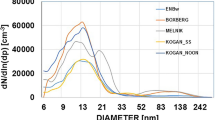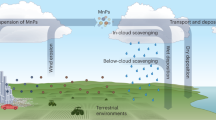Abstract
Atmospheric particulate matter influences the Earth’s energy balance directly, by altering or absorbing solar radiation, and indirectly by influencing cloud formation1. Whether organic particulate matter exists in a liquid, semi-solid, or solid state can affect particle growth and reactivity2,3, and hence particle number, size and composition. The properties and abundance of particles, in turn, influence their direct and indirect effects on energy balance4. Non-liquid particulate matter was identified over a boreal forest of Northern Europe5, but laboratory studies suggest that, at higher relative humidity levels, particles can be liquid6,7. Here we measure the physical state of particulate matter with diameters smaller than 1 μm over the tropical rainforest of central Amazonia in 2013. A real-time particle rebound technique shows that the particulate matter was liquid for relative humidity greater than 80% for temperatures between 296 and 300 K during both the wet and dry seasons. Combining these findings with the distributions of relative humidity and temperature in Amazonia, we conclude that near-surface sub-micrometre particulate matter in Amazonia is liquid most of the time during both the wet and the dry seasons.
This is a preview of subscription content, access via your institution
Access options
Subscribe to this journal
Receive 12 print issues and online access
$259.00 per year
only $21.58 per issue
Buy this article
- Purchase on Springer Link
- Instant access to full article PDF
Prices may be subject to local taxes which are calculated during checkout


Similar content being viewed by others
References
Ramanathan, V., Crutzen, P. J., Kiehl, J. T. & Rosenfeld, D. Atmosphere-aerosols, climate, and the hydrological cycle. Science 294, 2119–2124 (2001).
Kuwata, M. & Martin, S. T. Phase of atmospheric secondary organic material affects its reactivity. Proc. Natl Acad. Sci. USA 109, 17354–17359 (2012).
Perraud, V. et al. Nonequilibrium atmospheric secondary organic aerosol formation and growth. Proc. Natl Acad. Sci. USA 109, 2836–2841 (2012).
Andreae, M. O. & Rosenfeld, D. Aerosol–cloud–precipitation interactions. Part 1. The nature and sources of cloud-active aerosols. Earth Sci. Rev. 89, 13–41 (2008).
Virtanen, A. et al. An amorphous solid state of biogenic secondary organic aerosol particles. Nature 467, 824–827 (2010).
Bateman, A. P., Bertram, A. K. & Martin, S. T. Hygroscopic influence on the semisolid-to-liquid transition of secondary organic materials. J. Phys. Chem. A 119, 4386–4395 (2015).
Song, M. et al. Relative humidity-dependent viscosities of isoprene-derived secondary organic material and atmospheric implications for isoprene-dominant forests. Atmos. Chem. Phys. 15, 5145–5159 (2015).
Koop, T., Bookhold, J., Shiraiwa, M. & Poschl, U. Glass transition and phase state of organic compounds: Dependency on molecular properties and implications for secondary organic aerosols in the atmosphere. Phys. Chem. Chem. Phys. 13, 19238–19255 (2011).
Riipinen, I. et al. The contribution of organics to atmospheric nanoparticle growth. Nature Geosci. 5, 453–458 (2012).
Riipinen, I. et al. Organic condensation: A vital link connecting aerosol formation to cloud condensation nuclei (CCN) concentrations. Atmos. Chem. Phys. 11, 3865–3878 (2011).
Murray, B. J. et al. Heterogeneous nucleation of ice particles on glassy aerosols under cirrus conditions. Nature Geosci. 3, 233–237 (2010).
Jimenez, J. L. et al. Evolution of organic aerosols in the atmosphere. Science 326, 1525–1529 (2009).
Martin, S. T. et al. Sources and properties of Amazonian aerosol particles. Rev. Geophys. 48, RG2002 (2010).
Shiraiwa, M., Ammann, M., Koop, T. & Poschl, U. Gas uptake and chemical aging of semisolid organic aerosol particles. Proc. Natl Acad. Sci. USA 108, 11003–11008 (2011).
Zaveri, R. A., Easter, R. C., Shilling, J. E. & Seinfeld, J. H. Modeling kinetic partitioning of secondary organic aerosol and size distribution dynamics: Representing effects of volatility, phase state, and particle-phase reaction. Atmos. Chem. Phys. 14, 5153–5181 (2014).
Vaden, T. D. et al. Evaporation kinetics and phase of laboratory and ambient secondary organic aerosol. Proc. Natl Acad. Sci. USA 108, 2190–2195 (2011).
Renbaum-Wolff, L. et al. Viscosity of α-pinene secondary organic material and implications for particle growth and reactivity. Proc. Natl Acad. Sci. USA 110, 8014–8019 (2013).
Kidd, C., Perraud, V., Wingen, L. M. & Finlayson-Pitts, B. J. Integrating phase and composition of secondary organic aerosol from the ozonolysis of α-pinene. Proc. Natl Acad. Sci. USA 111, 7552–7557 (2014).
Shiraiwa, M., Zuend, A., Bertram, A. K. & Seinfeld, J. H. Gas-particle partitioning of atmospheric aerosols: Interplay of physical state, non-ideal mixing and morphology. Phys. Chem. Chem. Phys. 15, 11441–11453 (2013).
Hallquist, M. et al. The formation, properties and impact of secondary organic aerosol: Current and emerging issues. Atmos. Chem. Phys. 9, 5155–5236 (2009).
Bateman, A. P., Belassein, H. & Martin, S. T. Impactor apparatus for the study of particle rebound: Relative humidity and capillary forces. Aerosol Sci. Technol. 48, 42–52 (2014).
Tsai, C. J., Pui, D. Y. H. & Liu, B. Y. H. Capture and rebound of small particles upon impact with solid-surfaces. Aerosol Sci. Technol. 12, 497–507 (1990).
Martin, S. T. et al. An overview of the Amazonian Aerosol Characterization Experiment 2008 (AMAZE-08). Atmos. Chem. Phys. 10, 11415–11438 (2010).
Wang, B. et al. Reactivity of liquid and semisolid secondary organic carbon with chloride and nitrate in atmospheric aerosols. J. Phys. Chem. A 119, 4498–4508 (2015).
Chen, Q. et al. Mass spectral characterization of submicron biogenic organic particles in the Amazon basin. Geophys. Res. Lett. 36, L20806 (2009).
Poschl, U. et al. Rainforest aerosols as biogenic nuclei of clouds and precipitation in the Amazon. Science 329, 1513–1516 (2010).
Chen, Q. et al. Submicron particle mass concentrations and sources in the Amazonian wet season (AMAZE-08). Atmos. Chem. Phys. 15, 3687–3701 (2015).
Varutbangkul, V. et al. Hygroscopicity of secondary organic aerosols formed by oxidation of cycloalkenes, monoterpenes, sesquiterpenes, and related compounds. Atmos. Chem. Phys. 6, 2367–2388 (2006).
Claeys, M. et al. Formation of secondary organic aerosols through photooxidation of isoprene. Science 303, 1173–1176 (2004).
Kalberer, M. et al. Identification of polymers as major components of atmospheric organic aerosols. Science 303, 1659–1662 (2004).
Martin, S. T. et al. Introduction: Observations and modeling of the green ocean Amazon (GoAmazon2014/5). Atmos. Chem. Phys. Discuss. 15, 30175–30210 (2015).
Hinds, W. C. Aerosol Technology: Properties, Behavior, and Measurement of Airborne Particles 2nd edn (Wiley, 1999).
Marple, V. A. & Willeke, K. Impactor design. Atmos. Environ. 10, 891–896 (1976).
Dahneke, B. The capture of aerosol particles by surfaces. J. Colloid Interface Sci. 37, 342–353 (1971).
Winkler, P. Relative humidity and the adhesion of atmospheric particles to the plates of impactors. J. Aerosol Sci. 5, 235–240 (1974).
Agarwal, J. K. & Sem, G. J. Continuous flow, single-particle-counting condensation nucleus counter. J. Aerosol Sci 11, 343–357 (1980).
Kelly, W. P. & McMurry, P. H. Measurement of particle density by inertial classification of differential mobility analyzer generated monodisperse aerosols. Aerosol Sci. Technol. 17, 199–212 (1992).
Brechtel, F. J. & Kreidenweis, S. M. Predicting particle critical supersaturation from hygroscopic growth measurements in the humidified TDMA. Part I: Theory and sensitivity studies. J. Atmos. Sci. 57, 1854–1871 (2000).
Rissler, J. et al. Size distribution and hygroscopic properties of aerosol particles from dry-season biomass burning in Amazonia. Atmos. Chem. Phys. 6, 471–491 (2006).
Acknowledgements
Institutional support was provided by the Central Office of the Brazil Large-Scale Biosphere Atmosphere Experiment in Amazonia (LBA) and the Brazil National Institute of Amazonian Research (INPA). We acknowledge the Atmospheric Radiation Measurement (ARM) Climate Research Facility, a user facility of the United States Department of Energy, Office of Science, sponsored by the Office of Biological and Environmental Research, and support from the Atmospheric System Research (ASR) Program of that office. Funding was obtained from the United States Department of Energy (DOE), the São Paulo Research Foundation (FAPESP), the Amazonas State Research Foundation (FAPEAM), and the Brazil Scientific Mobility Program (CsF/CAPES). The authors acknowledge the Air Resources Laboratory of the United States National Oceanic and Atmospheric Administration (NOAA) for the provision of the website http://www.ready.noaa.gov for use of HYSPLIT. The research described herein was conducted under scientific licence 001030/2012-4 of the Brazilian National Council for Scientific and Technological Development (CNPq). Y. Ishida and B. Takeshi are gratefully acknowledged for logistical support of the measurements.
Author information
Authors and Affiliations
Contributions
A.P.B. carried out measurements, processed and analysed data, and contributed to the writing. P.L., Y.Z., B.S. and G.C. aided in the measurements. Z.G. participated in data analysis. A.O.M., P.A. and R.A.F.S. served in leadership roles for the infrastructure of the measurements. P.A., A.K.B., L.V.R. and R.A.Z. contributed to interpretation and writing. S.T.M. served as principal investigator of the project and contributed to data analysis, interpretation, and writing.
Corresponding author
Ethics declarations
Competing interests
The authors declare no competing financial interests.
Supplementary information
Supplementary Information
Supplementary Information (PDF 6906 kb)
Rights and permissions
About this article
Cite this article
Bateman, A., Gong, Z., Liu, P. et al. Sub-micrometre particulate matter is primarily in liquid form over Amazon rainforest. Nature Geosci 9, 34–37 (2016). https://doi.org/10.1038/ngeo2599
Received:
Accepted:
Published:
Issue Date:
DOI: https://doi.org/10.1038/ngeo2599
This article is cited by
-
The viscosity of atmospherically relevant organic particles
Nature Communications (2018)
-
Global distribution of particle phase state in atmospheric secondary organic aerosols
Nature Communications (2017)
-
Complex three-dimensional self-assembly in proxies for atmospheric aerosols
Nature Communications (2017)
-
Nature's plasticized aerosols
Nature Geoscience (2016)



